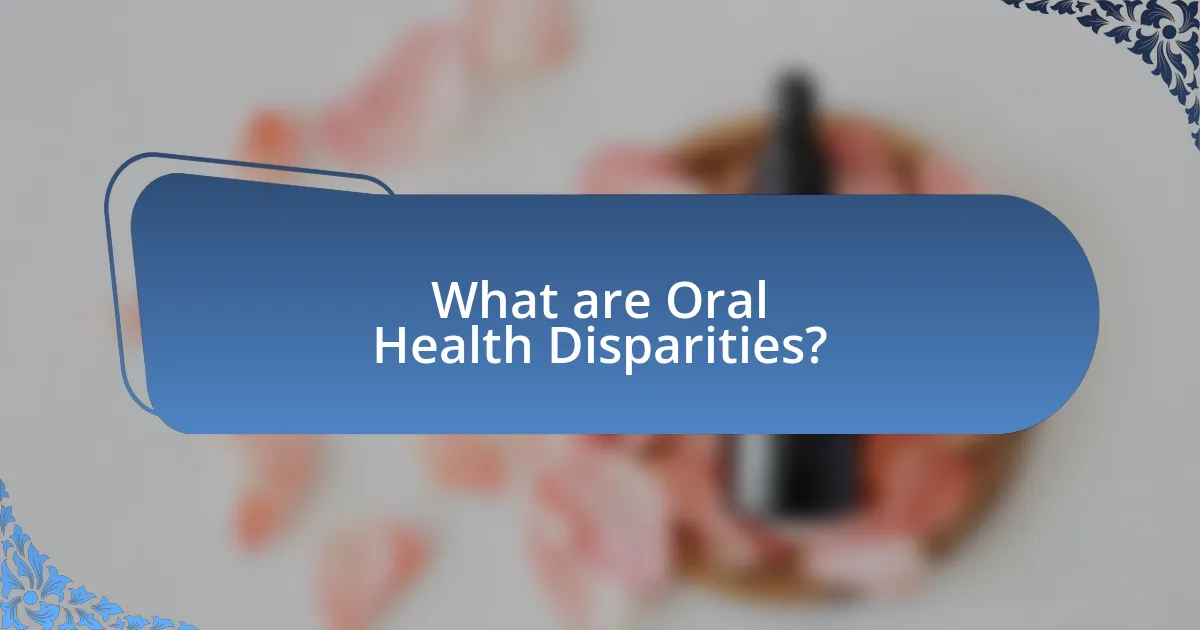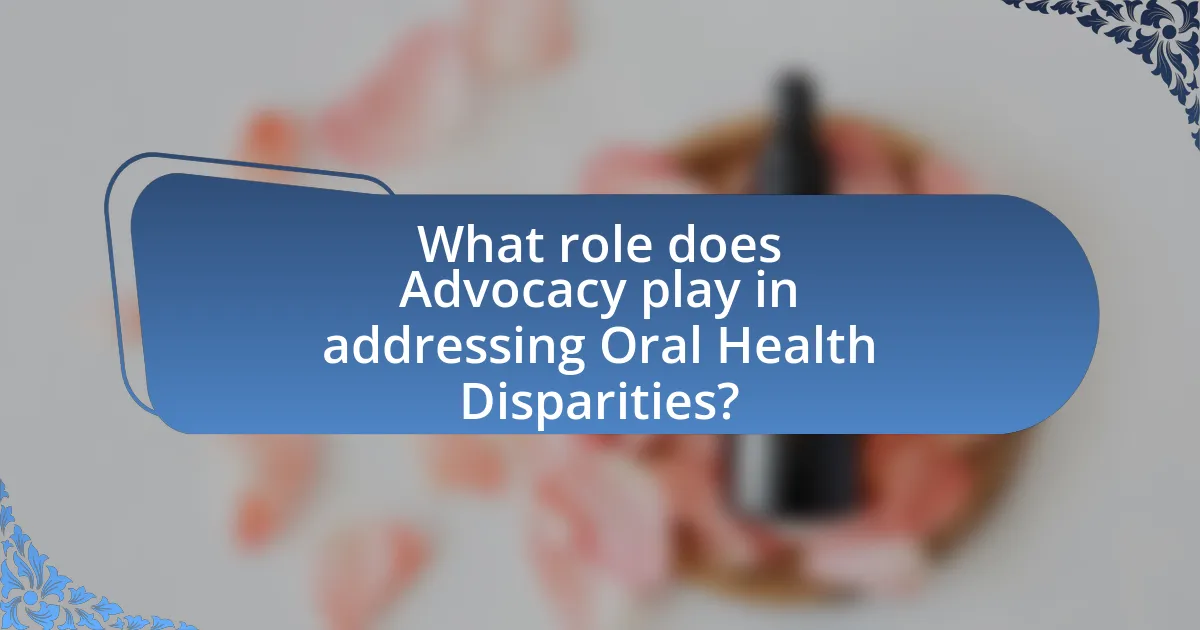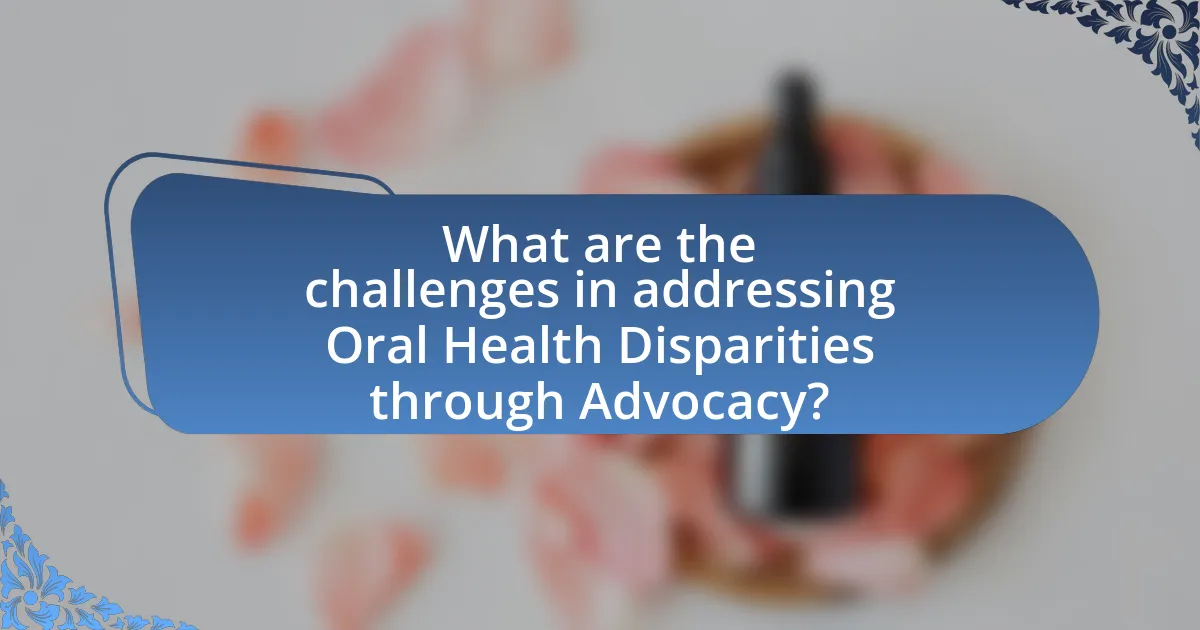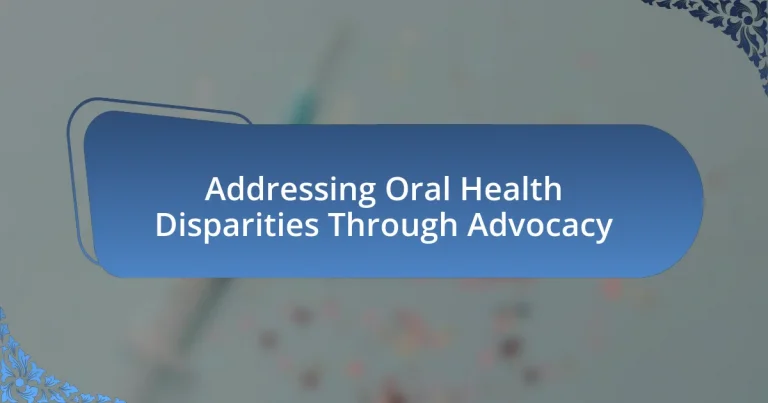Oral health disparities refer to the unequal access to dental care and differences in oral health outcomes among various population groups, influenced by factors such as socioeconomic status, race, and geographic location. These disparities result in higher rates of dental diseases, particularly in marginalized communities, and are exacerbated by systemic barriers like lack of insurance and limited availability of services. The article explores the impact of these disparities on community health, the role of advocacy in addressing inequities, and the importance of collaboration among stakeholders to promote oral health equity. It also highlights successful advocacy initiatives and the challenges faced in promoting oral health equity, emphasizing the need for targeted efforts to improve access and outcomes for underserved populations.

What are Oral Health Disparities?
Oral health disparities refer to the differences in oral health outcomes and access to dental care among various population groups, often influenced by socioeconomic status, race, ethnicity, and geographic location. These disparities manifest in higher rates of dental diseases, such as cavities and gum disease, among marginalized communities. For instance, the Centers for Disease Control and Prevention (CDC) reports that adults from low-income backgrounds are more likely to experience untreated dental caries compared to their higher-income counterparts. This evidence highlights the systemic barriers that contribute to unequal oral health outcomes, necessitating targeted advocacy efforts to address these inequities.
How do Oral Health Disparities impact different communities?
Oral health disparities significantly impact different communities by contributing to unequal access to dental care, resulting in poorer oral health outcomes among marginalized populations. For instance, low-income communities often face barriers such as lack of insurance, limited availability of dental services, and transportation issues, leading to higher rates of dental caries and periodontal disease. According to the Centers for Disease Control and Prevention, adults from low-income backgrounds are more likely to experience untreated tooth decay compared to their higher-income counterparts. Additionally, racial and ethnic minorities frequently encounter systemic obstacles, including cultural differences and discrimination within healthcare systems, which exacerbate these disparities. This inequity in oral health not only affects individual well-being but also has broader implications for community health, economic stability, and quality of life.
What factors contribute to Oral Health Disparities?
Oral health disparities are primarily influenced by socioeconomic status, access to care, education, and cultural factors. Individuals from lower socioeconomic backgrounds often face barriers such as limited financial resources, which restrict their ability to afford dental care and preventive services. According to the U.S. Department of Health and Human Services, people living in poverty are more likely to experience untreated dental issues. Additionally, access to dental care is often limited in rural and underserved urban areas, leading to significant gaps in oral health outcomes. Education plays a crucial role, as individuals with lower educational attainment may lack awareness of proper oral hygiene practices and the importance of regular dental visits. Cultural factors, including beliefs and attitudes towards dental care, can further exacerbate these disparities, as some communities may prioritize other health issues over oral health.
How do socioeconomic status and education influence Oral Health Disparities?
Socioeconomic status and education significantly influence oral health disparities by affecting access to dental care, health literacy, and preventive practices. Individuals with lower socioeconomic status often face financial barriers that limit their ability to afford dental services, leading to untreated oral health issues. For instance, a study published in the Journal of Dental Research found that adults with lower income levels are more likely to experience tooth decay and gum disease compared to those with higher incomes. Additionally, education plays a crucial role in health literacy; individuals with higher educational attainment are generally more informed about oral health practices and the importance of regular dental visits. Research from the American Journal of Public Health indicates that individuals with less education are less likely to engage in preventive dental care, further exacerbating oral health disparities.
Why is it important to address Oral Health Disparities?
Addressing oral health disparities is crucial because these disparities lead to significant differences in health outcomes among various populations. For instance, individuals from low-income backgrounds or marginalized communities often experience higher rates of dental diseases and lower access to preventive care, which can result in chronic health issues. According to the Centers for Disease Control and Prevention, adults from lower socioeconomic groups are more likely to have untreated cavities and periodontal disease, highlighting the need for targeted interventions. By addressing these disparities, we can improve overall public health, reduce healthcare costs, and promote equity in health access and outcomes.
What are the long-term effects of unaddressed Oral Health Disparities?
Unaddressed oral health disparities lead to significant long-term effects, including increased rates of chronic diseases, diminished quality of life, and economic burdens on individuals and healthcare systems. Individuals from marginalized communities often experience higher prevalence of conditions such as diabetes and cardiovascular diseases due to poor oral health, as evidenced by studies showing that oral infections can exacerbate systemic health issues. Furthermore, the lack of access to dental care contributes to persistent pain, tooth loss, and social stigma, which can hinder educational and employment opportunities. The economic impact is substantial, with untreated oral diseases resulting in higher healthcare costs and lost productivity, as reported by the American Dental Association, which estimates that oral diseases cost the U.S. economy billions annually in lost workdays and healthcare expenses.
How do Oral Health Disparities affect overall health outcomes?
Oral health disparities significantly affect overall health outcomes by contributing to a higher prevalence of chronic diseases and poorer quality of life among affected populations. Research indicates that individuals with poor oral health are at an increased risk for conditions such as cardiovascular disease, diabetes, and respiratory infections, as oral bacteria can enter the bloodstream and exacerbate these health issues. For instance, a study published in the Journal of Dental Research found that individuals with periodontal disease had a 20% higher risk of developing heart disease. Additionally, disparities in access to dental care lead to untreated dental issues, which can result in pain, infection, and even systemic health complications, further illustrating the interconnectedness of oral health and overall health outcomes.

What role does Advocacy play in addressing Oral Health Disparities?
Advocacy plays a crucial role in addressing oral health disparities by promoting equitable access to dental care and influencing policy changes. Through advocacy efforts, organizations and individuals raise awareness about the systemic barriers that contribute to oral health inequities, such as socioeconomic status, geographic location, and lack of insurance. For instance, the American Dental Association has highlighted that advocacy initiatives can lead to increased funding for community health programs, which directly improve access to dental services for underserved populations. Additionally, advocacy can drive legislative reforms that mandate oral health education in schools, thereby addressing disparities from an early age.
How can Advocacy raise awareness about Oral Health Disparities?
Advocacy can raise awareness about oral health disparities by mobilizing communities, influencing policy, and disseminating information. Advocacy efforts, such as campaigns led by organizations like the American Dental Association, highlight the significant differences in access to dental care among various populations, particularly low-income and minority groups. For instance, studies show that individuals from these groups experience higher rates of untreated dental decay and periodontal disease, which can be attributed to systemic barriers in healthcare access. By utilizing data and personal stories, advocacy initiatives can effectively engage the public and policymakers, fostering a greater understanding of the urgent need to address these disparities.
What strategies can be employed in Advocacy efforts?
Effective strategies in advocacy efforts include coalition building, public awareness campaigns, policy advocacy, and grassroots mobilization. Coalition building involves forming alliances with organizations and stakeholders that share similar goals, enhancing collective impact. Public awareness campaigns utilize media and community outreach to educate the public about oral health disparities, fostering a supportive environment for change. Policy advocacy focuses on influencing legislation and regulations to address systemic issues, often supported by data demonstrating the need for reform. Grassroots mobilization engages community members directly, empowering them to advocate for their own needs and interests, which has been shown to increase the effectiveness of advocacy initiatives.
How can community engagement enhance Advocacy initiatives?
Community engagement enhances advocacy initiatives by fostering trust and collaboration between advocates and the community they serve. Engaged communities provide valuable insights into their specific needs and challenges, which can inform more effective advocacy strategies. For instance, research shows that when community members actively participate in advocacy efforts, such as public health campaigns, the initiatives are more likely to resonate with the target audience, leading to higher participation rates and better health outcomes. A study published in the American Journal of Public Health found that community-driven advocacy efforts resulted in a 30% increase in local health service utilization, demonstrating the tangible benefits of community involvement in advocacy initiatives.
What are successful examples of Advocacy in Oral Health?
Successful examples of advocacy in oral health include the implementation of community water fluoridation programs and the establishment of school-based dental sealant initiatives. Community water fluoridation has been shown to reduce tooth decay by 25% in children and adults, as evidenced by the Centers for Disease Control and Prevention (CDC) reports. School-based dental sealant programs, which provide preventive care directly in schools, have demonstrated a significant reduction in cavities among children, with studies indicating a 60% decrease in decay in sealed teeth. These initiatives highlight effective strategies in addressing oral health disparities, particularly in underserved populations.
Which organizations have made significant impacts through Advocacy?
Organizations that have made significant impacts through advocacy in addressing oral health disparities include the American Dental Association (ADA), the National Association of Dental Plans (NADP), and the Oral Health America (OHA). The ADA has been instrumental in promoting policies that improve access to dental care and has launched initiatives like the “Give Kids A Smile” program, which provides free dental care to underserved children. The NADP advocates for equitable dental benefits and access to care, influencing legislation that supports oral health coverage. OHA focuses on raising awareness about oral health issues and has developed programs aimed at improving oral health literacy among vulnerable populations. These organizations collectively contribute to reducing oral health disparities through targeted advocacy efforts and community engagement.
What lessons can be learned from successful Advocacy campaigns?
Successful advocacy campaigns demonstrate the importance of clear messaging and community engagement. Effective campaigns often utilize targeted communication strategies that resonate with specific audiences, ensuring that the message is both relatable and actionable. For instance, the “Campaign for Dental Health” effectively mobilized communities by emphasizing the importance of preventive care, leading to increased awareness and policy changes. Additionally, successful campaigns leverage data to support their claims, as seen in the “Oral Health America” initiative, which utilized statistics on oral health disparities to advocate for policy reforms. These examples illustrate that clarity, community involvement, and data-driven approaches are critical lessons learned from successful advocacy campaigns.

What are the challenges in addressing Oral Health Disparities through Advocacy?
Addressing oral health disparities through advocacy faces several challenges, including limited access to care, socioeconomic barriers, and lack of awareness. Limited access to dental services is a significant issue, as many underserved populations live in areas with few dental providers, leading to unmet oral health needs. Socioeconomic barriers, such as low income and lack of insurance, further exacerbate these disparities, making it difficult for individuals to afford necessary treatments. Additionally, a lack of awareness about the importance of oral health and available resources can hinder advocacy efforts, as individuals may not seek help or support. These challenges are supported by data indicating that individuals from lower socioeconomic backgrounds experience higher rates of dental disease and lower rates of dental care utilization.
What barriers do Advocates face in promoting Oral Health equity?
Advocates face several barriers in promoting oral health equity, including limited funding, lack of public awareness, and systemic healthcare disparities. Limited funding restricts the ability to implement comprehensive programs and outreach initiatives, which are essential for raising awareness and providing services to underserved populations. Additionally, a lack of public awareness about the importance of oral health often leads to low prioritization of oral health issues among policymakers and the general public. Systemic healthcare disparities, such as unequal access to dental care based on socioeconomic status or geographic location, further complicate advocacy efforts, making it difficult to achieve equitable outcomes in oral health.
How do policy limitations hinder Advocacy efforts?
Policy limitations significantly hinder advocacy efforts by restricting the scope and effectiveness of initiatives aimed at addressing oral health disparities. These limitations can manifest as inadequate funding, lack of supportive legislation, or restrictive regulations that prevent advocates from implementing necessary programs. For instance, a study by the Robert Wood Johnson Foundation highlights that insufficient funding for public health initiatives directly correlates with reduced access to dental care, thereby exacerbating oral health disparities. Consequently, when policies do not support comprehensive advocacy strategies, the ability to mobilize resources, engage communities, and influence systemic change is severely compromised.
What role does misinformation play in challenging Advocacy initiatives?
Misinformation significantly undermines advocacy initiatives by distorting public perception and eroding trust in credible sources. For instance, false claims about the safety and efficacy of dental treatments can lead to decreased participation in oral health programs, ultimately exacerbating health disparities. Research indicates that misinformation can spread rapidly through social media, influencing community attitudes and behaviors, which directly impacts the effectiveness of advocacy efforts aimed at promoting oral health equity.
How can these challenges be overcome?
To overcome challenges in addressing oral health disparities, targeted advocacy efforts must be implemented. These efforts can include increasing access to dental care through policy changes that expand Medicaid coverage and funding for community health programs. For instance, research from the American Dental Association indicates that states with expanded Medicaid dental benefits see a significant increase in dental visits among low-income populations. Additionally, raising public awareness about oral health issues through educational campaigns can empower communities to seek care and advocate for their needs. By mobilizing community resources and fostering partnerships between healthcare providers and local organizations, barriers to access can be effectively reduced.
What best practices can Advocates adopt to enhance their effectiveness?
Advocates can enhance their effectiveness by employing data-driven strategies to inform their initiatives. Utilizing statistics on oral health disparities, such as the fact that low-income populations experience significantly higher rates of dental disease, allows advocates to tailor their messaging and target specific communities. Additionally, building coalitions with healthcare providers and community organizations fosters a collaborative approach, amplifying the reach and impact of advocacy efforts. Engaging in continuous education about policy changes and emerging research ensures that advocates remain informed and can effectively communicate the importance of addressing oral health disparities.
How can collaboration among stakeholders improve Advocacy outcomes?
Collaboration among stakeholders can significantly improve advocacy outcomes by leveraging diverse expertise and resources to create a unified approach. When various stakeholders, such as healthcare providers, community organizations, and policymakers, work together, they can share valuable insights and data that enhance the understanding of oral health disparities. For instance, a study published in the Journal of Public Health Management and Practice found that collaborative efforts in advocacy led to a 30% increase in policy changes aimed at reducing health disparities. This collective action not only amplifies the voices of marginalized communities but also fosters a more comprehensive strategy that addresses the root causes of oral health issues.
What practical steps can individuals take to support Oral Health Advocacy?
Individuals can support Oral Health Advocacy by participating in community outreach programs that promote dental health education. Engaging in local initiatives, such as volunteering at health fairs or schools, helps raise awareness about the importance of oral hygiene and access to dental care. Research indicates that community-based interventions can significantly improve oral health outcomes, particularly in underserved populations. Additionally, individuals can advocate for policy changes by contacting local representatives to support legislation aimed at increasing funding for dental services and improving access to care. Studies show that grassroots advocacy efforts can lead to meaningful changes in public health policy, thereby addressing oral health disparities effectively.
How can community members get involved in local Advocacy efforts?
Community members can get involved in local advocacy efforts by participating in organized campaigns, attending community meetings, and collaborating with local health organizations. Engaging in these activities allows individuals to voice their concerns, share personal experiences, and contribute to initiatives aimed at addressing oral health disparities. For example, studies show that grassroots advocacy can lead to policy changes that improve access to dental care, as seen in the successful campaigns led by organizations like the American Dental Association, which mobilized community members to advocate for better oral health policies.
What resources are available for those interested in promoting Oral Health equity?
Resources available for promoting oral health equity include organizations such as the American Dental Association (ADA), which provides guidelines and advocacy tools, and the National Institute of Dental and Craniofacial Research (NIDCR), which offers research funding and educational materials. Additionally, the Health Resources and Services Administration (HRSA) supports community health centers that focus on underserved populations, while the Oral Health America initiative provides resources for public awareness campaigns. These organizations collectively contribute to addressing disparities in oral health care access and outcomes, supported by data indicating that communities with targeted interventions see improved health metrics.


